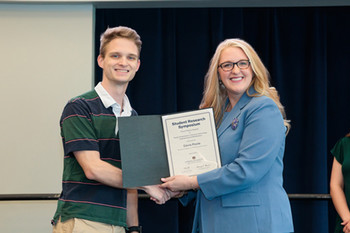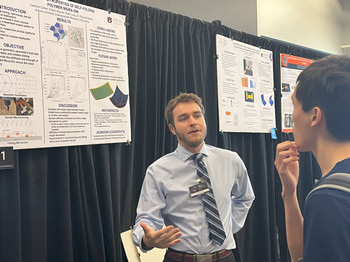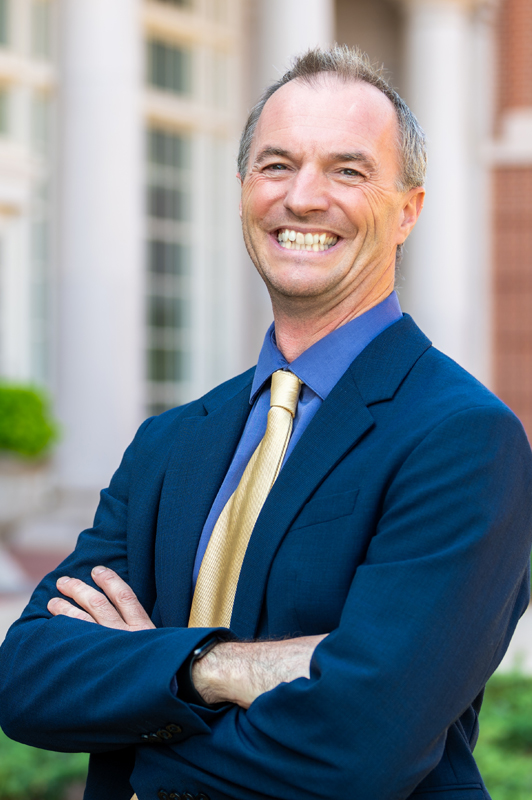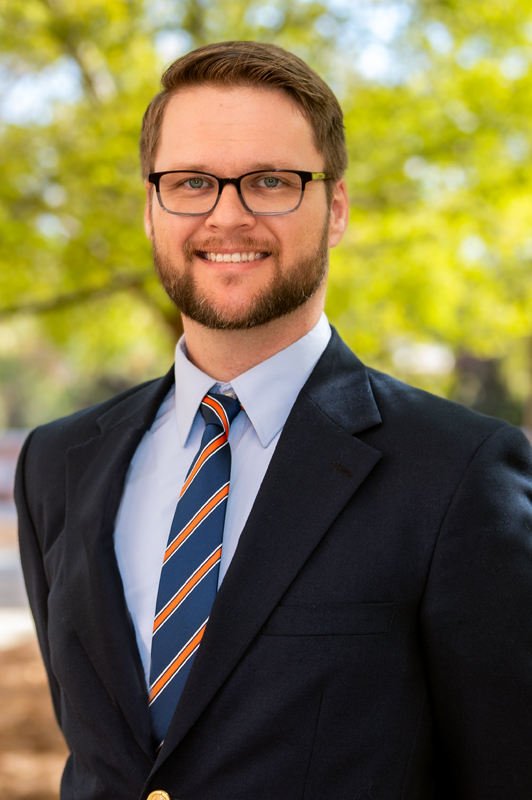Auburn Engineering students well-represented at Auburn University Research Symposium
Published: Apr 3, 2025 4:00 PM
By Joe McAdory
Two Auburn Engineering students earned university-wide third-place awards for graduate and undergraduate research at the annual Auburn University Research Symposium held March 26 at the Melton Student Center, where 486 students and postdoctoral researchers presented their work before faculty and peers.

Davis Poole, who will earn a master’s degree in mechanical engineering in May, was recognized in the STEM graduate category for his presentation, “Design and Stiffness Emulation Robot.”
With Kimberly B. Garza, associate professor of health outcomes and research policy at the Harrison College of Pharmacy and Chad Rose, assistant professor in the Department of Mechanical Engineering, Poole’s research explored the development of a robotic system to simulate joint stiffness for medical and rehabilitation applications.
Cameron Cohen, a senior in aerospace engineering and program manager for the Auburn University Small Satellite Program, also earned third place in the STEM undergraduate category for his research, “Mechanical Properties of Self-folding Polymer Miura Ori.” With Evelyn Squires and Russell Mailen, associate professor in the Department of Aerospace Engineering, Cohen's research creates lightweight, deployable space structures for applications like telescopes and solar arrays.

Each of the university’s respective colleges also featured winners for graduate and undergraduate poster and oral presentations.
Zachary Miller, who is working toward a master’s degree in mechanical engineering, won Auburn Engineering’s graduate award for his poster presentation, “Using a Long-Short-Term Memory Model to Classify Essential Tremor Severity.” With Jamie Roper, associate professor in the School of Kinesiology and Kenneth Harrison, a graduate research assistant in the School of Kinesiology, this study develops a custom network to analyze motion data from essential tremor (ET) patients, validating the accuracy of Tremor Research Group Essential Tremor Rating Assessment Scale scores for assessing ET severity and enabling automated, at-home diagnosis.
Max Miller, a senior in industrial and systems engineering, won the college’s undergraduate award for his poster presentation, “Improving human-exoskeleton coordination through modification of the torque’s rise and fall time control parameters in powered ankle exoskeleton.” This research develops a new exoskeleton controller to analyze how changes in torque timing and stiffness affect human gait, improving exoskeleton design for enhanced human-system interaction.
Najibullah Zulfeqar, who is working toward a doctorate in civil engineering, won the college’s graduate award for his oral presentation, “Nano-Enhanced Electrokinetic Conditioning of Expansive Soils Using MgO Nanoparticles.” This study showed that using magnesium oxide nanoparticles and electrokinetic methods can significantly improve the stability and strength of expansive soils.
Robert Hudson, a senior in aerospace engineering, won the college’s undergraduate award for his oral presentation, “High throughput stochastic rare event buckling analysis of lattice structures.” The desired result: improved reliability and safety of aerospace structures by efficiently gathering data on the buckling behavior of lattice shells, leading to better design and higher mission success rates.
“Our annual symposium showcases Auburn University’s dedication to fostering innovation and advancing research that addresses real-world challenges,” said Lorenzo Cremaschi, director of undergraduate research at Auburn University and professor in the Department of Mechanical Engineering. “The achievements of our students highlight the university’s role in shaping the future of STEM fields. With groundbreaking research spanning robotics, renewable energy, agriculture, biomedical and social sciences, Auburn continues to be a hub of ingenuity and academic excellence.”
Media Contact: , jem0040@auburn.edu, 334.844.3447
The annual research symposium attracted 486 students and postdoctoral researchers.




